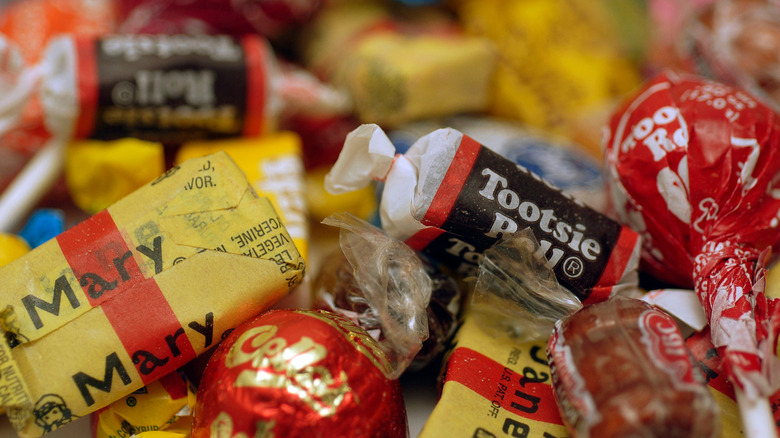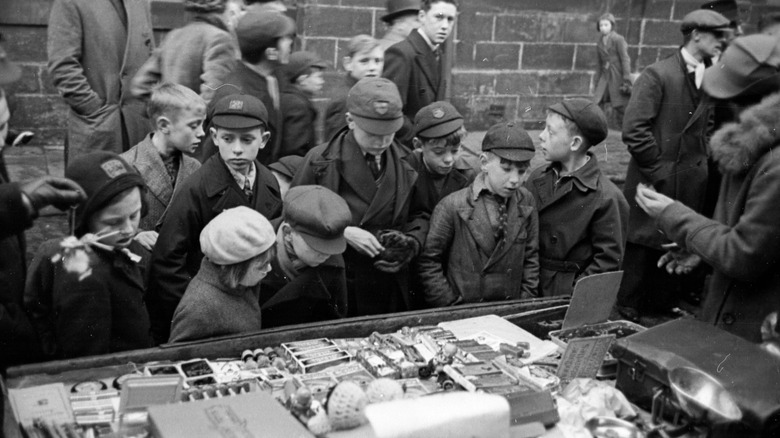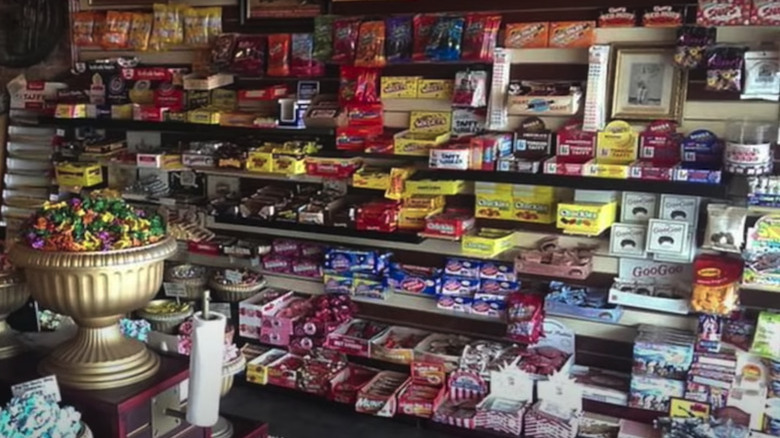The Nostalgic History Of Penny Candy Stores
There's something about an old-fashioned penny candy store that even the most discerning among us find hard to resist. We may turn up our noses at mass-produced chocolate bars in favor of our secret stash of hand-crafted truffles but set us loose in the candy aisle of an old-time five-and-dime, and those self-imposed standards crumble as we peruse the kaleidoscopic array of everything from fireballs and licorice sticks to blow pops and buckeyes. But why? Let's face it, the sweets themselves aren't all that great. The sight of colorful candy buttons may make us swoon, but did anyone ever manage to eat one of the pastel-colored sugar dots without also consuming a sliver of the paper backing? So, if the actual penny candy isn't the draw, what is it about an old-fashioned candy store that tugs at our heartstrings?
Nostalgia, of course. Ironically, though, the genesis of penny candy wasn't driven by a desire to create a magical shopping experience for children. Instead, the history of penny candy as we know it today is rooted in a marketing strategy conceived by the founder of the F.W. Worthworth Co. In 1879, when he opened the first location of what would become his namesake brand, Frank Woolworth had a plan. Not unlike Costco and their rotisserie chickens, Woolworth believed a strategically placed display of inexpensive candy was the key to success.
The lure of penny candy
According to a 2011 article in The Saturday Evening Post, Frank Woolworth's first five-and-dime in Utica, New York offered everything from household goods to children's toys. But before they could get to the more practical products, customers — and their eagle-eyed children — had to pass by an elaborate candy display strategically placed just inside the entrance to the store. Woolworth's theory as told to The Saturday Evening Post: "I don't pretend to know much about the candy business, but, in my opinion, if you want to make a big success of candy, put it in brass trays and put it up near the door, so that people can be reminded of it as they are passing out and take some home to the children."
Clearly, Woolworth's strategy had an impact. In 1979, as the F.W. Worthworth Co. celebrated its 100th anniversary in business, Guinness World Records named the brand the world's largest department store chain. While the now-defunct retail giant capitalized on its elaborate displays of penny candy, Woolworth didn't invent the once-cent confections, but just offered a wider — and grander — array than was previously available at smaller stores and pharmacies. The owners of neighborhood mom-and-pop shops took note, so by the mid-20th century, the penny candy display at the corner variety store became a destination in its own right, luring kids with the promise of a brown paper bag filled to the brim with sweets that ranged from 1 to 50 cents.
Penny candy today
Inflation, big box stores, jam-packed after-school schedules led to the eventual demise of the corner store, but shop online and you can still find some of the mainstays once featured in old-fashioned candy displays. Then again, it was never really about the candy. The real draw for many of us was the heady, if temporary, sense of sovereignty our 10-year-old selves experienced with a pocketful of coins and the freedom to choose whatever caught our fancy.
Maybe that's why places like 1856 General Store in Centerville, Massachusetts, Old Country Store in Moultonborough, New Hampshire, and Elsah General Store in Elsah, Illinois — all located in popular family vacation destinations — continue to thrive as parents and grandparents who grew up during the heyday of penny candy stores long to share that nostalgic simplicity with tech-savvy kids of the 21st century.
Even Hollywood hotshot Steve Carell is a fan. When a longtime neighborhood general store in Marshfield, Massachusetts went up for sale in 2008, Carrell and his wife Nancy bought the business — not for its prime location in a coastal New England town, but to continue the tradition for future generations. "I grew up in Acton, and there was a general store in Sutton that we always went to," Carrell told The Things in 2020. "It went out of business, as many of them do, and I just wanted to keep this operating as a general store." Is there a penny candy aisle at Carrell's Marshfield General Store? Of course!


